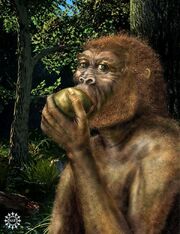
From Hunters and Gatherers to Farmers
The above video clip explores the transition of modern Homo sapiens from a lifestyle of hunting and gathering to the controlled use of domestic agriculture

The above picture is a depiction of Paranthropus boisei, "Nutcracker Man", an ancient hominid ancestor living between 2.3 and 1.2 million years ago
Over the approximate 5-6 million years of documented hominid existence, several major changes in the human diet have occurred. Generally, it is believed that humans evolved from strongly herbaceous roots, and over time, gradually evolved to develop a more diverse diet consisting of both plant and animal-based foods diet (Arjamaa & Vuorisalo, 2010; Mann, 2007; Milton, 1999; Luca et al., 2010).
Diet of Early Ancestral Humans[]
Craniodental specimen analysis of some of the oldest known human ancestors reveals that early hominids most likely consumed a strongly herbivorous diet, consisting primarily of soft fruits (Teaford & Ungar, 2000). Gradual changes in tooth size and enamel thickness of Australopithecine hominids living between the time of approximately 4 to 2 million years ago suggest a transition to a slightly broader diet which may have included more hard and brittle foods such as seeds and nuts (Teaford & Ungar, 2000).
Starting in the late-Pliocene, some researchers believe that the climate slowly shifted to become drier, and more arid, possibly making high-quality plant foods harder to procure. As a result, some speculate that the early human diet also shifted and began utilizing both plant and animal foods (Arjamaa & Vuorisalo, 2010; Mann, 2007; Milton, 1999). Hunting and gathering tendencies appeared to largely persist throughout the Paleolithic Period until the start of the Agricultural Revolution approximately 12,000 years ago (Arjamaa & Vuorisalo, 2010).
Post Agricultural Human Diet[]
The most recent, and perhaps most drastic, shift in human diet began approximately 10,000-12,000 years ago with the introduction of domestic agriculture and animal husbandry (Cordain et al., 2005; Luca et al., 2010). At this point, the human diet began to steadily shift away from wild plant and animal foods towards many new and less nutrient-dense domestic foods, (Cordain et al., 2005). Beginning during the Industrial Revolution about 200 years ago, advances in food production and processing led to even greater changes in the human diet. During the same period, diet-related diseases, including cardiovascular disease, type II diabetes, cancer, and obesity, experienced a dramatic rise, particularly in the West (Cordain et al., 2005). This has led some to speculate that human biological evolution was simply unable to keep up with these rapid changes in diet and lifestyle, and as a result, adverse health consequences have ensued (Cordain et al., 2005; Eaton & Eaton; 2000, Krebs, 2009; Roberts, 1988)
References
Arjamaa, O., & Vuorisalo, T. (2010). Gene-Culture Coevolution and Human Diet. American Scientist, 98(2), 140-147.
Cordain, L., Eaton, S., Sebastian, A., Mann, N., Lindeberg, S., Watkins, B., & ... Brand-Miller, J. (2005). Origins and evolution of the Western diet: Health implications for the 21st century. American Journal of Clinical Nutrition, 81(2), 341-354.
Eaton, S., & Eaton III, S. (2000). Paleolithic vs. modern diets--selected pathophysiological implications. European Journal of Nutrition, 39(2), 67.
Krebs, J. (2009). The gourmet ape: Evolution and human food preferences. American Journal of Clinical Nutrition, 90(3S), 707S-711. doi:10.3945/ajcn.2009.27462B
Luca, F. F., Perry, G. H., & Di Rienzo, A. A. (2010). Evolutionary adaptations to dietary changes. Annual Review of Nutrition, 30(1), 291-314.
Mann, N. N. (2007). Meat in the human diet: An anthropological perspective. Nutrition and Dietetics, 64(S4), S102-S107. doi:10.1111/j.1747-0080.2007.00194.x
Milton, K. (1999). A hypothesis to explain the role of meat-eating in human evolution. Evolutionary Anthropology, 8(1), 11-21
Roberts, W. C. (1988). Stone agers in the atomic age: lessons from the Paleolithic life-style for modern man. The American Journal of Cardiology, 61(15), 1365-1366.
Teaford, M., & Ungar, P. (2000). Diet and the evolution of the earliest human ancestors. Proceedings of the National Academy of Sciences of the United States of America, 97(25), 13506-13511.